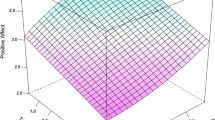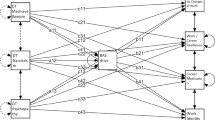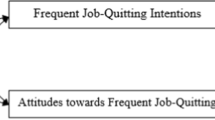Abstract
This longitudinal study examines the influence of dispositional affect,defined as self-rated cheerfulness at college entry, on three job outcomes – current income, job satisfaction, and unemployment history – assessedabout 19 years later. Analysis shows that individuals with a highercheerfulness rating at college entry have a higher current income and ahigher job satisfaction rating and are less likely ever to have beenunemployed than individuals with a lower cheerfulness rating. Althoughcheerfulness generally has a positive effect on current income, this effectis curvilinear, with current income increasing more rapidly at lower thanat higher cheerfulness ratings; the effect is also moderated by parentalincome, with the increase in current income between any two cheerfulnessratings becoming greater as the level of parental income increases. Theeffect of cheerfulness on current income is not moderated by sex; the effectof cheerfulness on job satisfaction and on unemployment history is notmoderated by either sex or parental income.
Similar content being viewed by others
REFERENCES
Abelson, R.P.: 1985, 'A variance explanation paradox: When a little is a lot', Psychological Bulletin 97, pp. 129-133.
Aiken, L.S. and S.G. West: 1991, Multiple Regression: Testing and Interpreting Interactions (Sage, Newbury Park, CA).
Alexander, E.R. III and R.D. Wilkins: 1982, 'Performance rating validity: The relationship of objective and subjective measures of performance', Group & Organization Studies 7, pp. 485-496.
Alicke, M.: 1985, 'Global self-evaluation as determined by the desirability and controllability of trait adjectives', Journal of Personality and Social Psychology 49, pp. 1621-1630.
Arvey, R.D., T.J. Bouchard, Jr., N.L. Segal and L.M. Abraham: 1989, 'Job satisfaction: Environmental and genetic components', Journal of Applied Psychology 74, pp. 187-192.
Astin, A.W., M.R. King and G.T. Richardson: 1976, The American Freshman: National Norms for Fall 1976 (Cooperative Institutional Research Program of the American Council on Education and the University of California at Los Angeles, Graduate School of Education, Laboratory for Research in Higher Education, Los Angeles).
Barrick, M.R. and M.K. Mount: 1991, 'The Big Five personality dimensions and job performance: A meta-analysis', Personnel Psychology 44, pp. 1-26.
Block, J.: 1961, The Q-sort Method in Personality Assessment and Psychiatric Research (Charles C. Thomas, Springfield, IL).
Bowen, W.G. and D. Bok: 1998, The Shape of the River: Long-term Consequences of Considering Race in College and University Admissions (Princeton University Press, Princeton, NJ).
Brief, A.P., M.J. Burke, J.M. George, B.S. Robinson and J. Webster: 1988, 'Should negative affectivity remain an unmeasured variable in the study of job stress?' Journal of Applied Psychology 73, pp. 193-198.
Brief, A.P., A.H. Butcher and L. Roberson: 1995, 'Cookies, disposition, and job attitudes: The effects of positive mood-inducing events and negative affectivity on job satisfaction in a field experiment', Organizational Behavior and Human Decision Processes 62, pp. 55-62.
Burger, J.M. and D.F. Caldwell: 2000, 'Personality, social activities, job-search behavior, and interview success: Distinguishing between PANAS trait positive affect and NEO extraversion', Motivation and Emotion 24, pp. 51-62.
Caldwell, D.F. and J.M. Burger: 1998, 'Personality characteristics of job applicants and success in screening interviews', Personnel Psychology 51, pp. 119-136.
Cardy, R.L. and G.H. Dobbins: 1986, 'Affect and appraisal accuracy: Liking as an integral dimension of evaluating performance', Journal of Applied Psychology 71, pp. 672-678.
Champoux, J.E. and W.S. Peters: 1980, 'Applications of moderated regression in job design research', Personnel Psychology 33, pp. 759-783.
Cohen, J. and P. Cohen: 1983, Applied Multiple Regression/Correlation Analysis for the Behavioral Sciences (2nd ed.). (Erlbaum, Hillsdale, NJ).
Cooper, W.H.: 1981, 'Ubiquitous halo', Psychological Bulletin 90, pp. 218-244.
Cropanzano, R., K. James and M.A. Konovsky: 1993, 'Dispositional affectivity as a predictor of work attitudes and job performance', Journal of Organizational Behavior 14, pp. 595-606.
Darlington, R.B.: 1990,Regression and Linear Models (international ed.). (McGraw-Hill, New York).
Davis, J.A.: 1985, The Logic of Causal Order. Sage University Paper Series on Quantitative Applications in the Social Sciences, 07-055 (Sage, Newbury Park, CA).
Davis-Blake, A. and J. Pfeffer: 1989, 'Just a mirage: The search for dispos-itional effects in organizational research', Academy of Management Review 114, pp. 385-400.
Diener, E.: 1984, 'Subjective well-being', Psychological Bulletin 95, pp. 542-575.
Diener, E.: 1999, [Percentage of waking time experiencing various feelings during a typical day]. Unpublished raw data.
Diener, E., E.M. Suh, R.E. Lucas and H.L. Smith: 1999, 'Subjective well-being: Three decades of progress', Psychological Bulletin, 125, pp. 276-302.
Dodge, A.F.: 1938, 'Social dominance and sales personality', Journal of Applied Psychology 22, pp. 132-139.
Dodge, A.F.: 1943, 'What are the personality traits of the successful teacher?' Journal of Applied Psychology 27, pp. 325-337.
Dunning, D., J.A. Meyerowitz and A.D. Holzberg: 1989, 'Ambiguity and self-evaluation: The role of idiosyncratic trait definitions in self-serving assessments of ability', Journal of Personality and Social Psychology 57, pp. 1082-1090.
Endler, N.S.: 1973, 'The person versus the situation–A pseudo issue? A response to Alker', Journal of Personality 41, pp. 287-303.
Friedman, H.: 1972, Introduction to Statistics (Random House, New York).
Friedrich, R.J.: 1982, 'In defense of multiplicative terms in multiple regression equations', American Journal of Political Science 26, pp. 797-833.
George, J.M.: 1989, 'Mood and absence', Journal of Applied Psychology 74, pp. 317-324.
Gerhart, B.: 1987, 'How important are dispositional factors as determinants of job satisfaction? Implications for job design and other personnel programs', Journal of Applied Psychology 72, pp. 366-373.
Ghiselli, E.E. and R.P. Barthol: 1953, 'The validity of personality inventories in the selection of employees', Journal of Applied Psychology 37, pp. 18-20.
Guion, R.M. and R.F. Gottier: 1965, 'Validity of personality measures in personnel selection', Personnel Psychology 18, pp. 135-164.
Harrell, W.:1940,'Testing cotton mill supervisors', Journal of Applied Psychology 24, pp. 31-35.
Hochwater, W.A., K.L. Zellars, P.L. Perrewé and A.W. Harrison: 1999, 'The interactive role of negative affectivity and job characteristics: Are high-NA employees destined to be unhappy at work?' Journal of Applied Social Psychology 29, pp. 2203-2218.
House, R.J., A. Howard and G. Walker: 1991, 'The prediction of managerial success: A competitive test of the person-situation debate', Academy of Management Best Papers Proceedings 1991, pp. 215-219.
Jaccard, J., R. Turrisi and C.K. Wan: 1990, Interaction Effects in Multiple Regression. Sage University Paper Series on Quantative Applications in the Social Sciences, 07-072 (Sage, Newbury Park, CA).
Judd, C.M. and G.H. McClelland: 1989, Data Analysis: A Model-comparison Approach (Harcourt Brace Jovanovich, San Diego, CA).
Judge, T.: 1992, 'The dispositional perspective in human resources research', in G.R. Ferris and K.M. Rowland (eds.), Research in Personnel and Human Resources Management (vol. 10) (JAI Press, Greenwich, CT, pp. 31-72).
Judge, T.A., D.M. Cable, J.W. Boudreau and R.D. Bretz, Jr.: 1995, 'An empirical investigation of the predictors of executive career success', Personnel Psychology 48, pp. 485-519.
Judge, T.A., C.A. Higgins, C.J. Thoresen and M.R. Barrick: 1999, 'The Big Five personality traits, general mental ability, and career success across the life span', Personnel Psychology 52, pp. 621-652.
Judge, T.A. and C.L. Hulin: 1993, 'Job satisfaction as a reflection of disposition: A multiple source causal analysis', Organizational Behavior and Human Decision Processes 56, pp. 388-421.
Judge, T.A., J.J. Martocchio and C.J. Thoresen: 1997, 'Five-factor model of personality and employee absence', Journal of Applied Psychology 82, pp. 745-755.
Judge, T.A., C.J. Thoresen, V. Pucik and T.M. Welbourne: 1999, 'Managerial coping with organizational change: A dispositional perspective', Journal of Applied Psychology 84, pp. 107-122.
Kruger, J.: 1999, 'Lake Wobegon be gone! The “below-average effect” and the egocentric nature of comparative ability judgments', Journal of Personality and Social Psychology 77, pp. 221-232.
Levin, I. and J.P. Stokes: 1989, 'Dispositional approach to job satisfaction: Role of negative affectivity', Journal of Applied Psychology 74, pp. 752-758.
Linton, M. and P.S. Gallo, Jr.: 1975, The Practical Statistician: Simplified Handbook of Statistics (Brooks/Cole, Monterey, CA).
Marks, G.N. and N. Fleming: 1999, 'Influences and consequences of well-being among Australian young people: 1980–1995', Social Indicators Research 46, pp. 301-323.
Maxwell, S.E. and H.D. Delaney: 1990, Designing Experiments and Analyzing Data: A Model Comparison Perspective (Brooks/Cole, Pacific Grove, CA).
McClelland, G.H. and C.M. Judd: 1993, 'Statistical difficulties of detecting interactions and moderator effects', Psychological Bulletin 114, pp. 376-390.
McFatter, R.M.: 1979, 'The use of structural equation models in interpreting regression equations including suppressor and enhancer variables', Applied Psychological Measurement 3, pp. 123-135.
Menard, S.: 1995, Applied Logistic Regression Analysis. Sage University Paper Series on Quantitative Applications in the Social Sciences, 07-106 (Sage, Thousand Oaks, CA).
Mischel, W.: 1968, Personality and Assessment (Wiley, New York).
Mischel, W.: 1977, 'The interaction of person and situation', in D. Magnusson and N.S. Endler (eds.), Personality at the Crossroads: Current Issues in Interactional Psychology (Erlbaum, Hillsdale, NJ, pp. 333-352).
Monson, T.C., J.W. Hesley and L. Chernick: 1982, 'Specifying when personality traits can and cannot predict behavior: An alternative to abandoning the attempt to predict single-act criteria', Journal of Personality and Social Psychology 43, pp. 385-399.
Necowitz, L.B. and M. Roznowski: 1994, 'Negative affectivity and job satisfaction: Cognitive processes underlying the relationship and effects on employee behaviors', Journal of Vocational Behavior 45, pp.270-294.
Nickerson, C., E. Diener, D. Kahneman and N. Schwarz: 1999, Positive Illusions and College Outcomes. Manuscript under review.
Nisbett, R.E.: 1980, 'The trait construct in lay and professional psychology', in L. Festinger (ed.), Retrospections on Social Psychology (Oxford University Press, New York, pp. 109-130).
Peterson, D.R.: 1968, The Clinical Study of Social Behavior (Appleton-Century-Crofts, New York).
Peterson, C., A. Semmel, C. von Baeyer, L.Y. Abramson, G.I. Metalsky and M.E.P. Seligman: 1982, 'The Attributional Style Questionnaire', Cognitive Therapy and Research 6, pp. 287-300.
Pulakos, E.D. and N. Schmitt: 1983, 'A longitudinal study of a valence model approach for the prediction of job satisfaction of new employees', Journal of Applied Psychology 68, pp. 307-312.
Rosenthal, R.: 1990, 'How are we doing in soft psychology?' American Psychologist 45, pp. 775-777.
Rosenthal, R. and D.B. Rubin: 1979, 'A note on percent variance explained as a measure of the importance of effects', Journal of Applied Social Psychology 9, pp. 395-396.
Rosenthal, R. and D.B. Rubin: 1982, 'A simple, general purpose display of magnitude of experimental effect', Journal of Educational Psychology 74, pp. 166-169.
Schwarz, N. and G.C. Clore: 1983, 'Mood, misattribution, and judgments of well-being: Informative and directive functions of affective states', Journal of Personality and Social Psychology 45, pp. 513-523.
Schwarz, N. and F. Strack: 1999, 'Reports of subjective well-being: Judgmental processes and their methodological implications', in D. Kahneman, E. Diener and N. Schwarz (eds.), Well-being: The Foundations of Hedonic Psychology (Russel Sage, New York, pp. 61-84).
Seligman, M.E.P. and P. Schulman: 1986, 'Explanatory style as a predictor of productivity and quitting among life insurance sales agents', Journal of Personality and Social Psychology 50, pp. 832-838.
Spector, P.E. and B.J. O'Connell: 1994, 'The contribution of personality traits, negative affectivity, locus of control, and Type A to the subsequent reports of job stressors and job strains', Journal of Occupational and Organizational Psychology 67, pp.1-11.
Staw, B.M.: 1986, 'Organizational psychology and the pursuit of the happy/ productive worker', California Management Review 28, pp. 40-53.
Staw, B.M. and S.G. Barsade: 1993, 'Affect and managerial performance: A test of the sadder-but-wiser vs. happier-and-smarter hypotheses', Administrative Science Quarterly 38, pp. 304-331.
Staw, B.M., N.E. Bell and J.A. Clausen: 1986, 'The dispositional approach to job attitudes: A lifetime longitudinal test',Administrative Science Quarterly 31, pp. 56-77.
Staw, B.M. and J. Ross: 1985, 'Stability in the midst of change: A dispositional approach to job attitudes', Journal of Applied Psychology 70, pp. 469-480.
Steering Committee of the Physicians' Health Study Research Group: 1988, 'Preliminary report: Findings from the aspirin component of the ongoing Physicians' Health Study', New England Journal of Medicine 318, pp. 262-264.
Stokes, J.P. and I.M. Levin: 1990, 'The development and validation of a measure of negative affectivity', Journal of Social Behavior and Personality 5(2), pp. 173-186.
Tzelgov, J. and I. Stern: 1978, 'Relationship between variables in three variable linear regression and the concept of suppressor', Educational and Psychological Measurement 38, pp. 325-335.
Watson, D. and L.A. Clark: 1984, 'Negative affectivity: The disposition to experience aversive emotional states', Psychological Bulletin 96, pp. 465-490.
Watson, D., L.A. Clark and A. Tellegen: 1988, 'Development and validation of brief measures of positive and negative affect: The PANAS Scales', Journal of Personality and Social Psychology 54, pp. 1063-1070.
Watson, D. and A.K. Slack: 1993, 'General factors of affective temperament and their relation to job satisfaction over time', Organizational Behavior and Human Decision Processes 54, pp. 181-202.
Weitz, J.: 1952, 'A neglected concept in the study of job satisfaction', Personnel Psychology 5, pp. 201-205.
Wright, T.A., D.G. Bonett and D.A. Sweeney: 1993, 'Mental health and work performance: Results of a longitudinal field study', Journal of Occupational and Organizational Psychology 66, pp. 277-284.
Wright, T.A. and B.M. Staw: 1999, 'Affect and favorable work outcomes: Two longitudinal tests of the happy-productive worker thesis', Journal of Organizational Behavior 20, pp. 1-23.
Yeaton, W.H. and L. Sechrest: 1981, 'Meaningful measures of effect', Journal of Counseling and Clinical Psychology 49, pp. 766-767.
Author information
Authors and Affiliations
Rights and permissions
About this article
Cite this article
Diener, E., Nickerson, C., Lucas, R.E. et al. Dispositional Affect and Job Outcomes. Social Indicators Research 59, 229–259 (2002). https://doi.org/10.1023/A:1019672513984
Issue Date:
DOI: https://doi.org/10.1023/A:1019672513984




